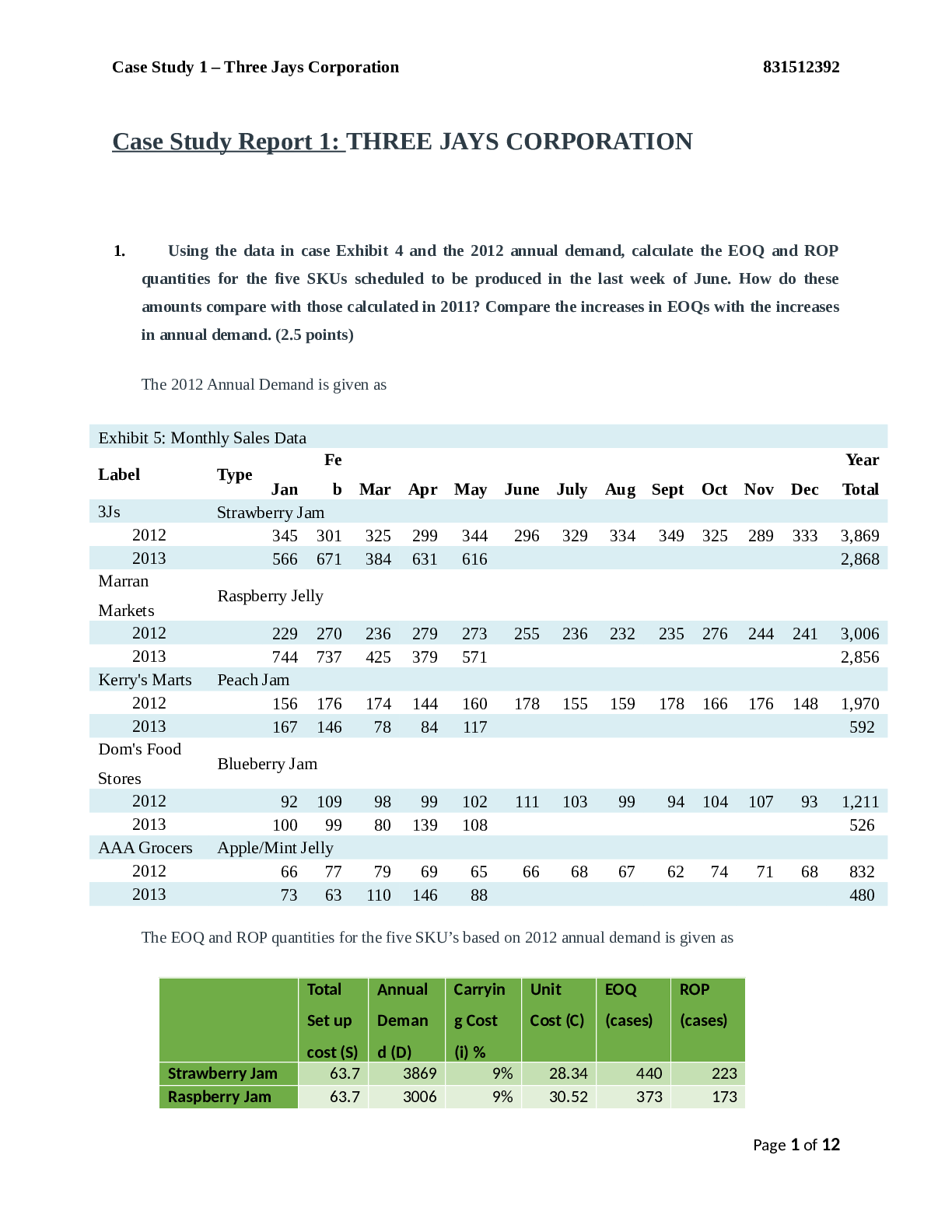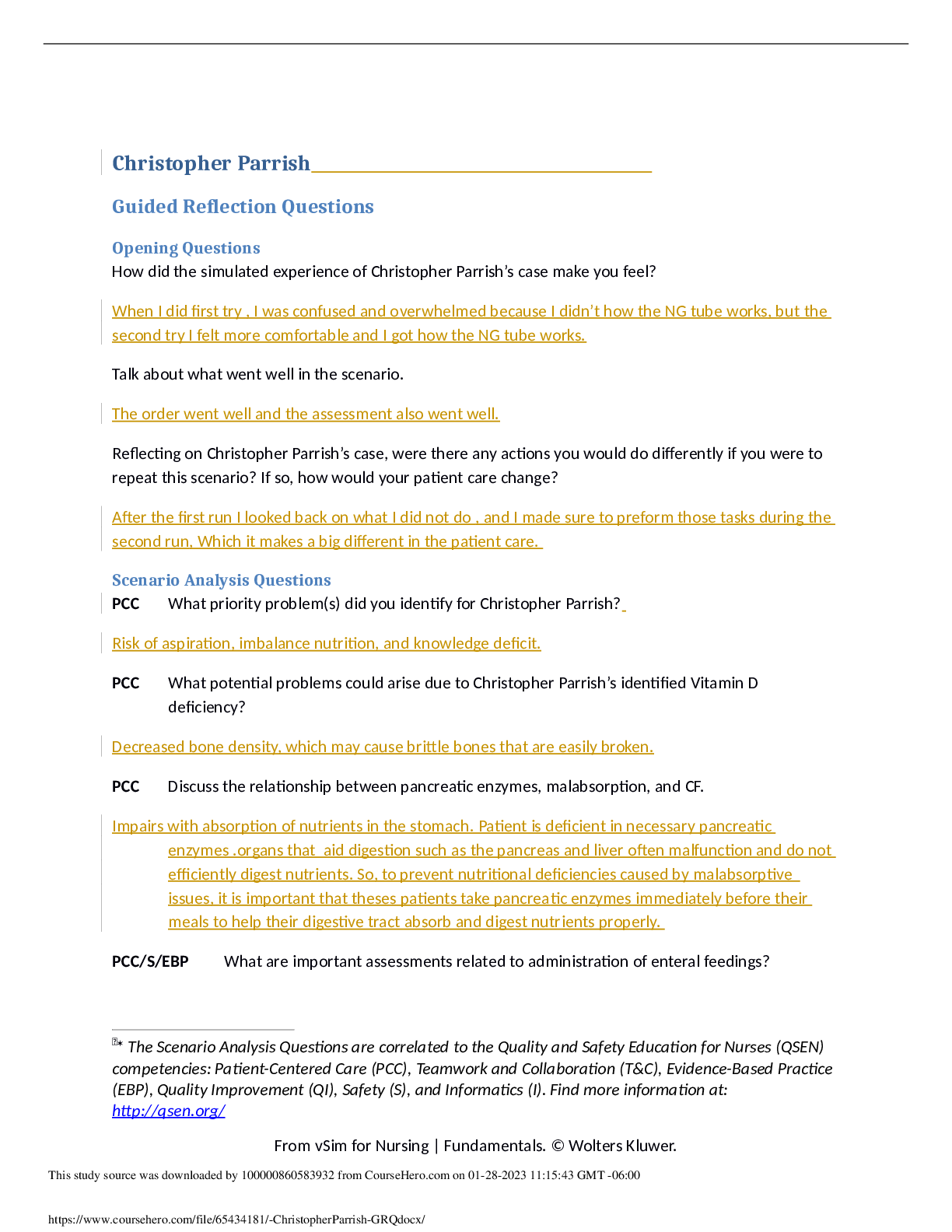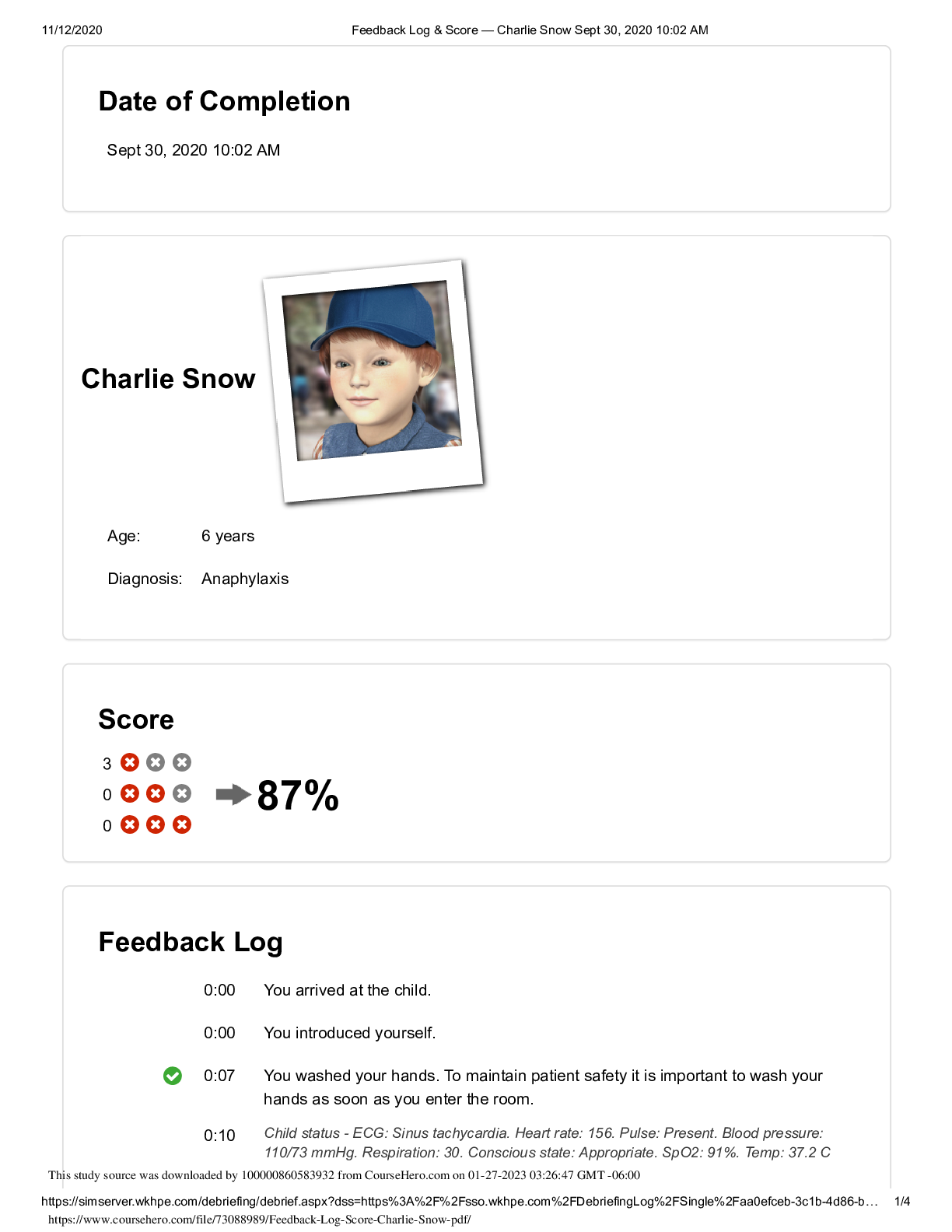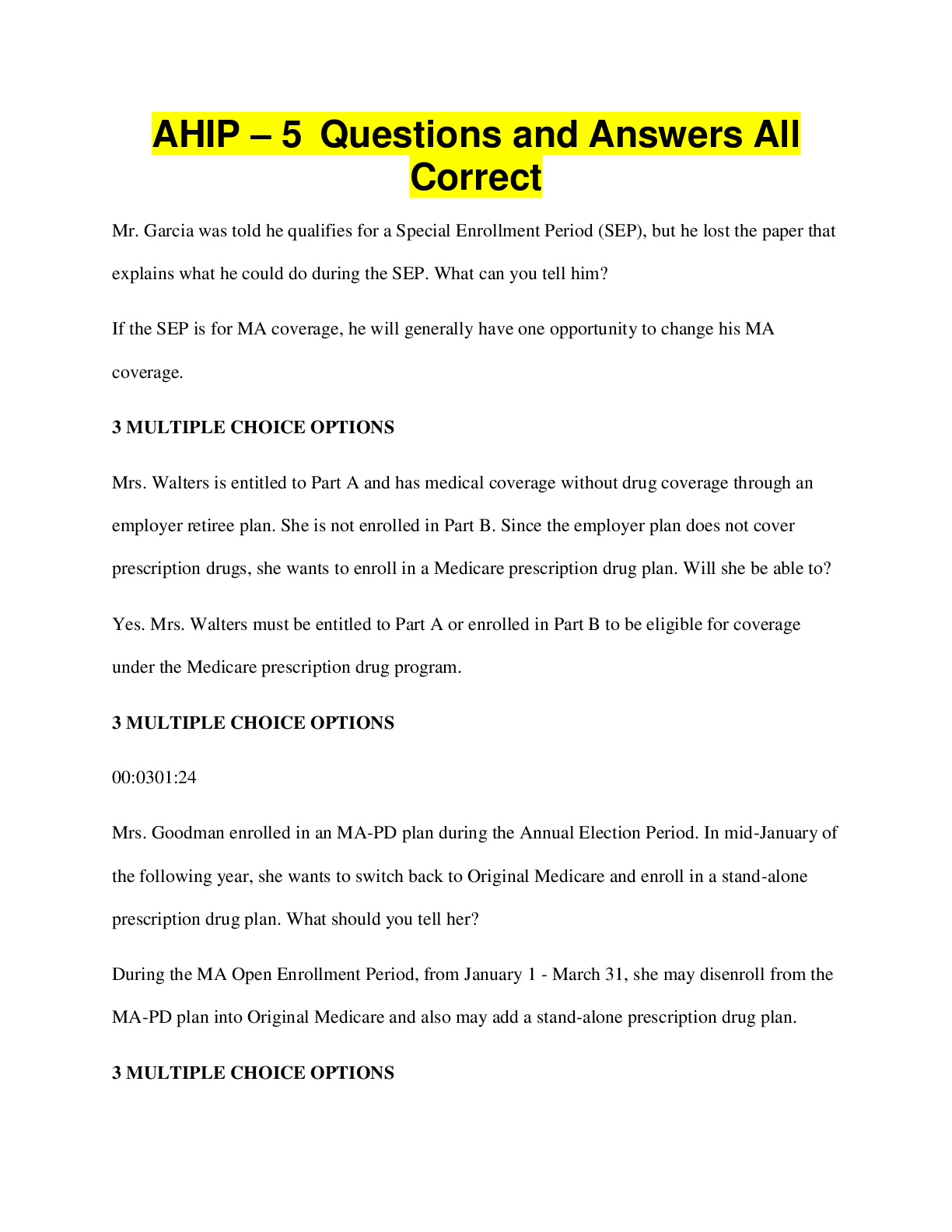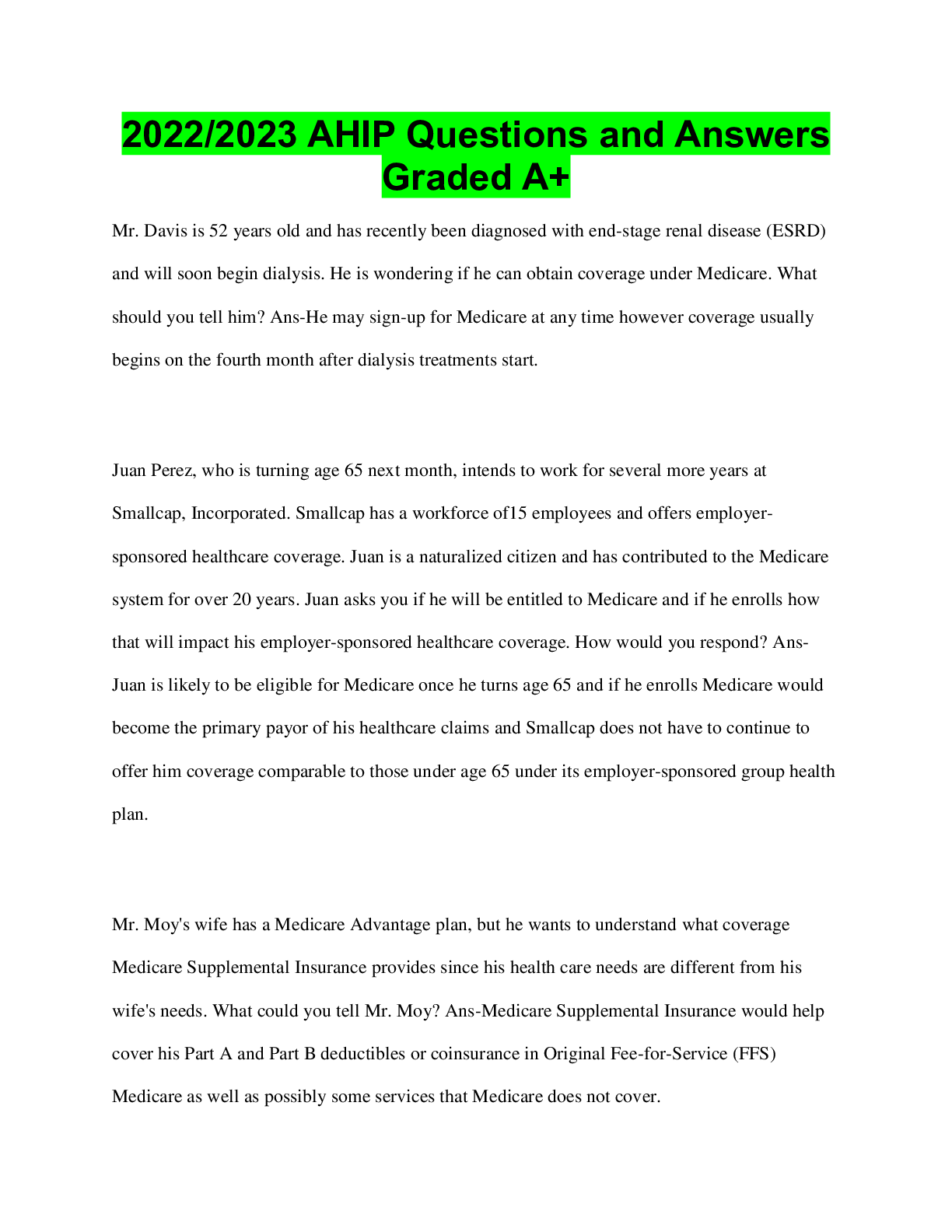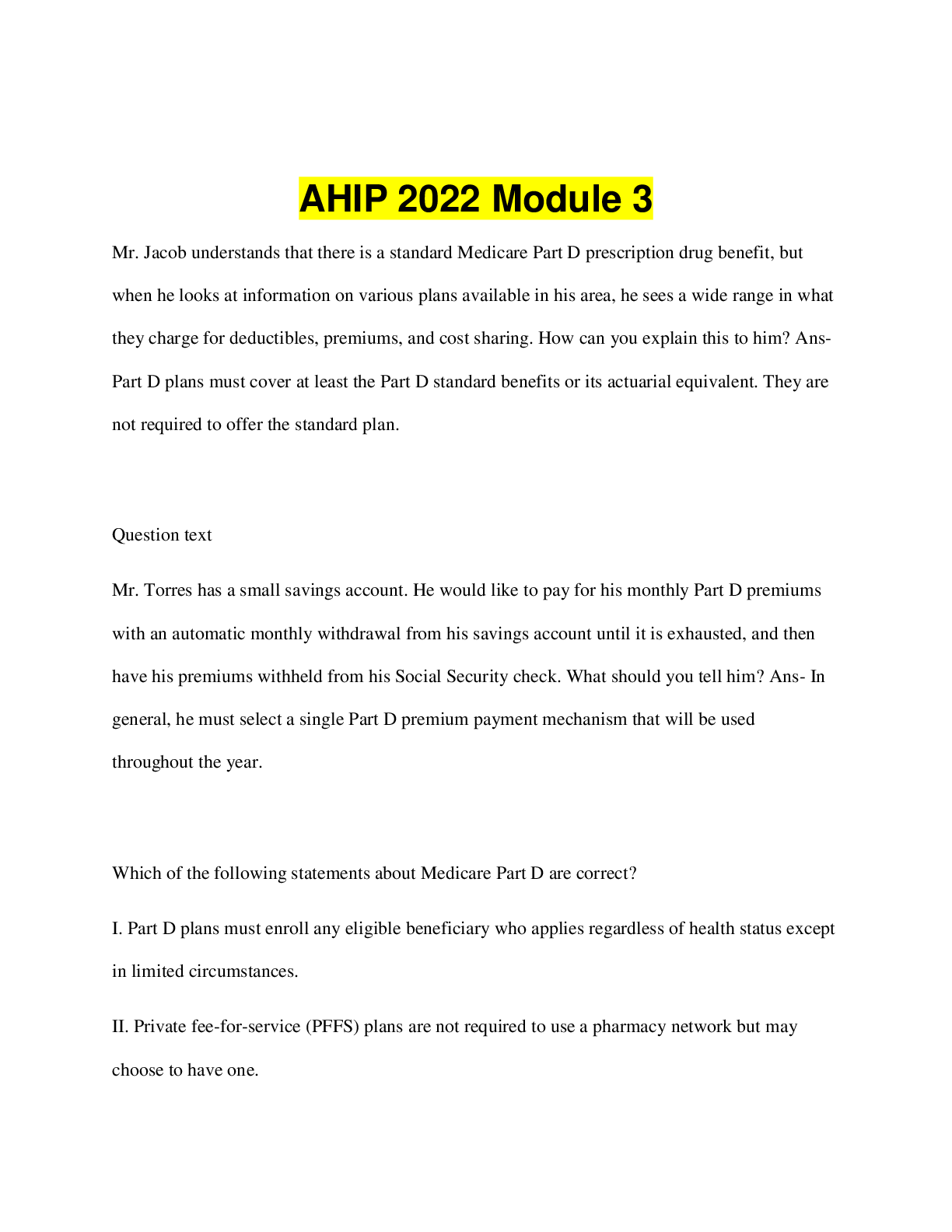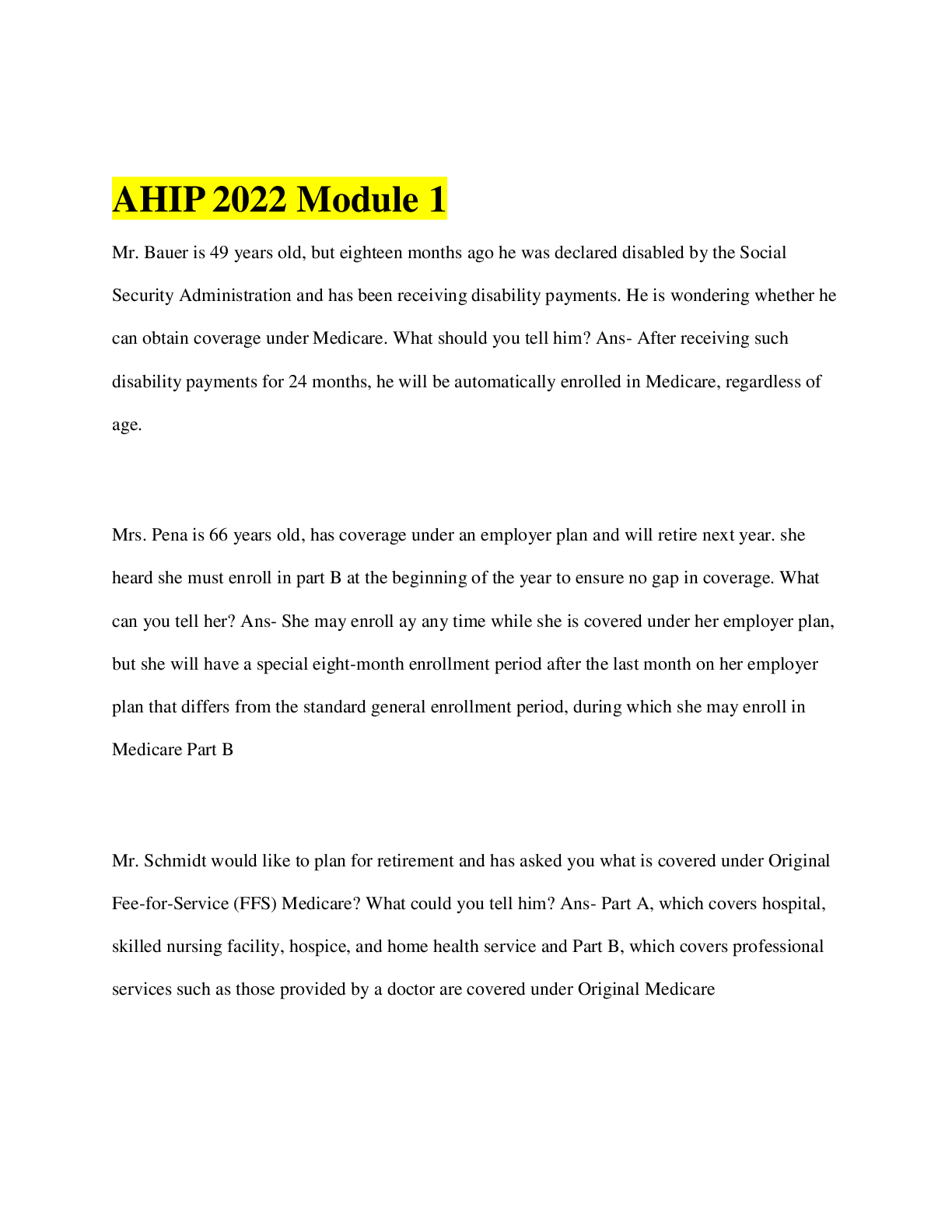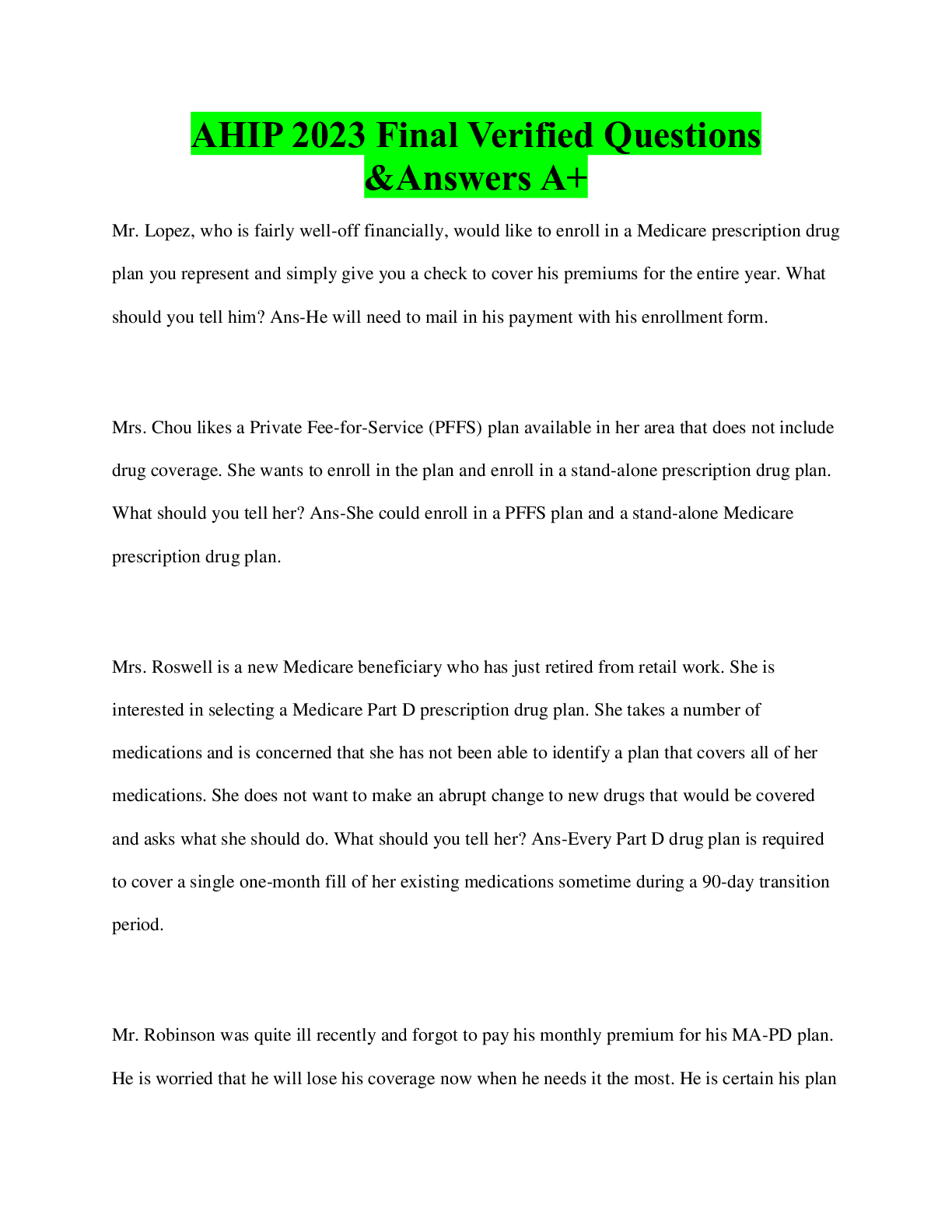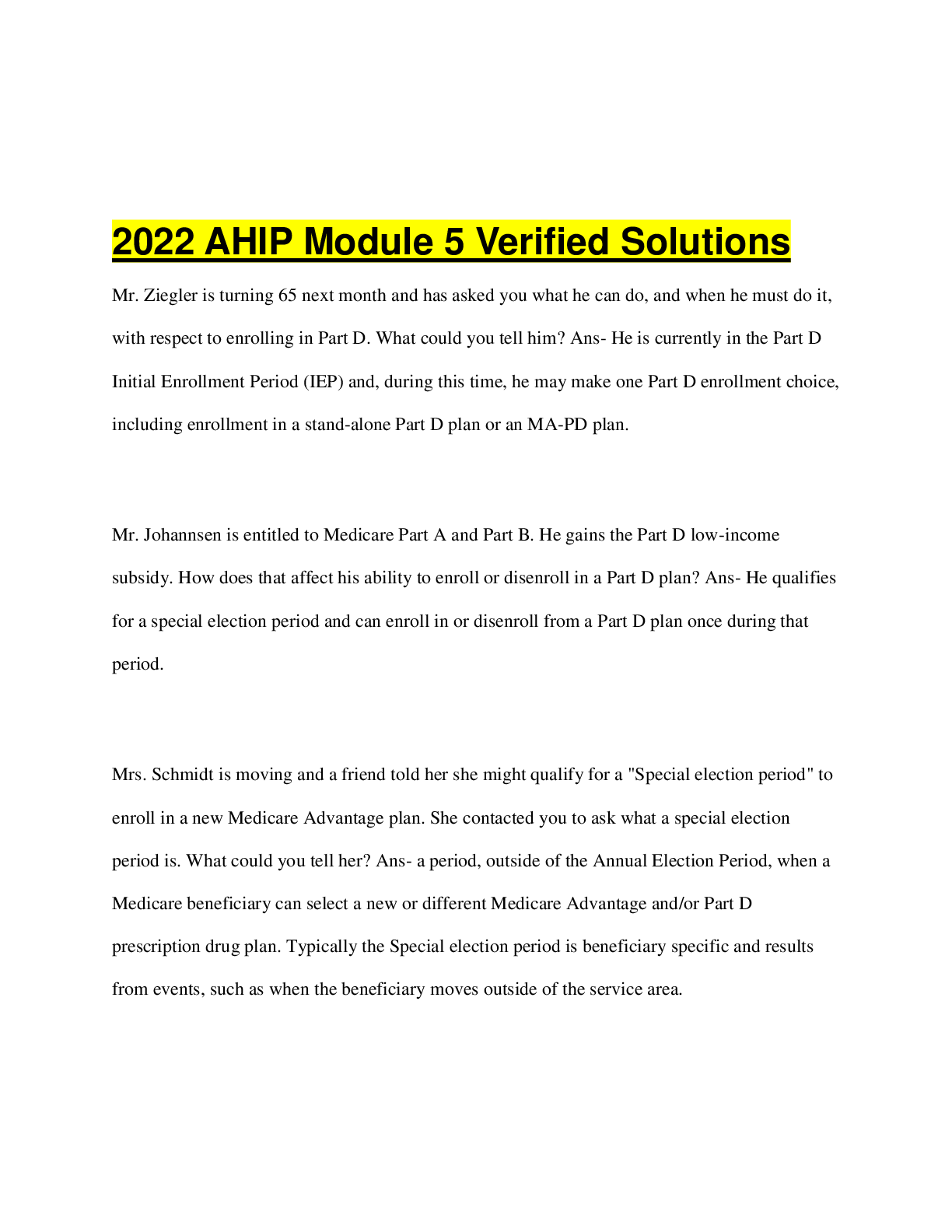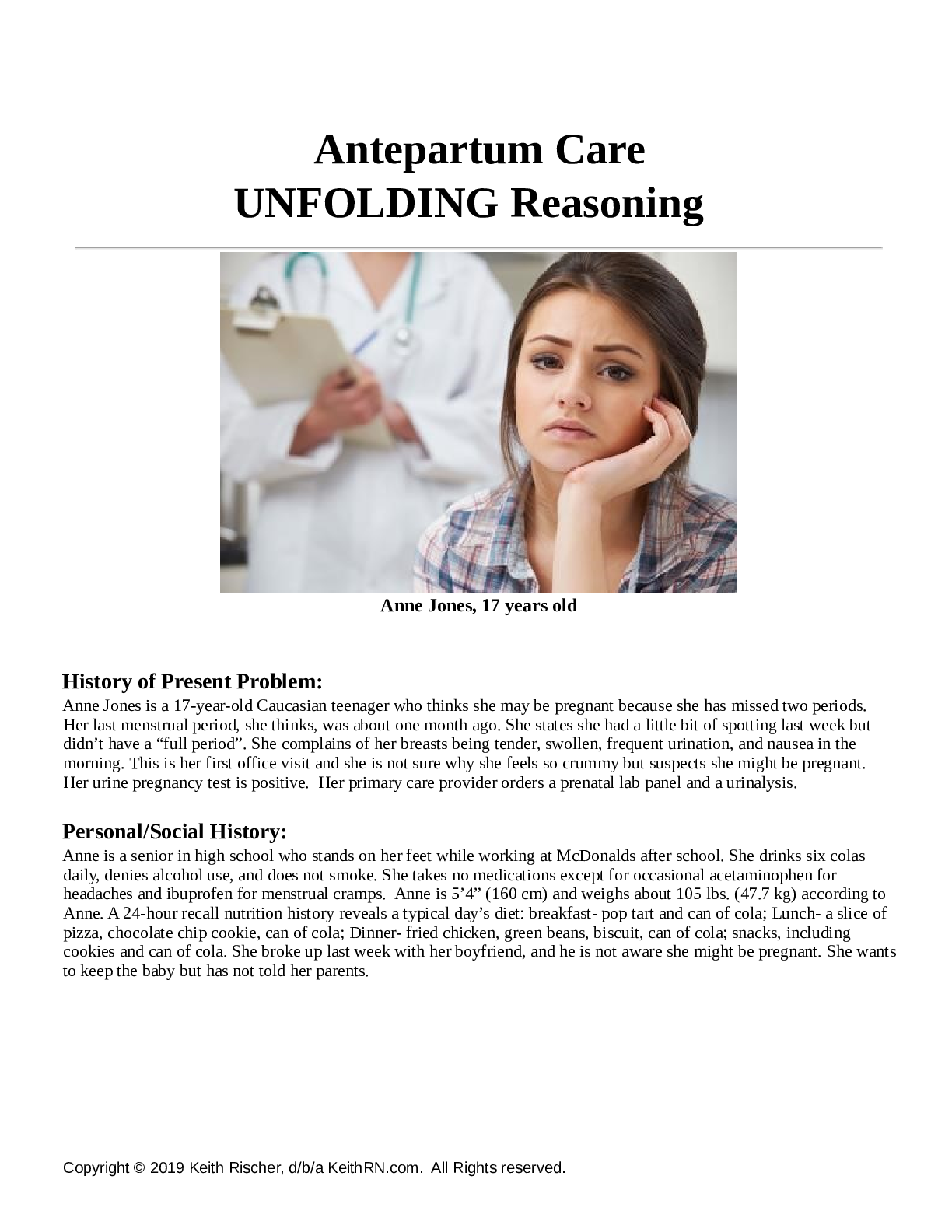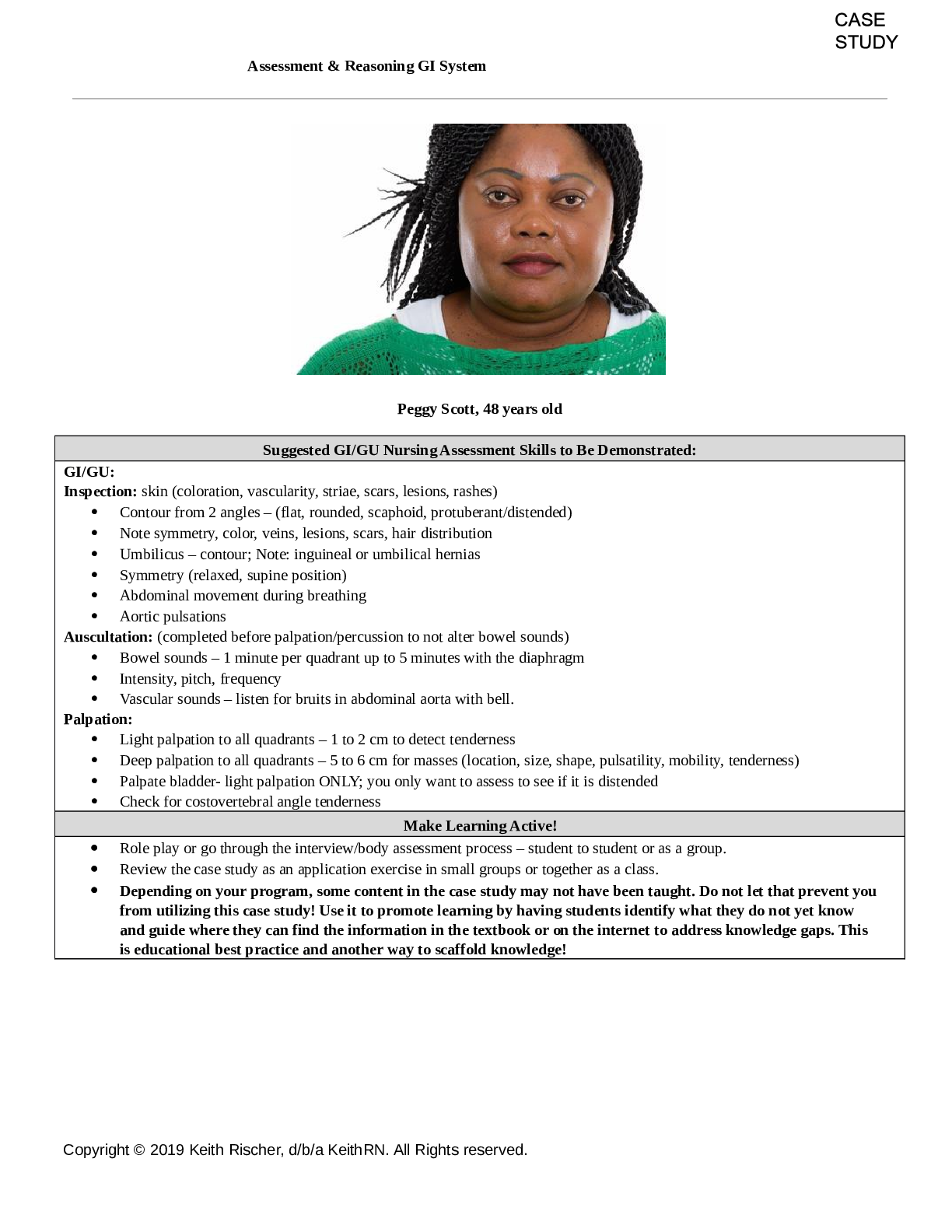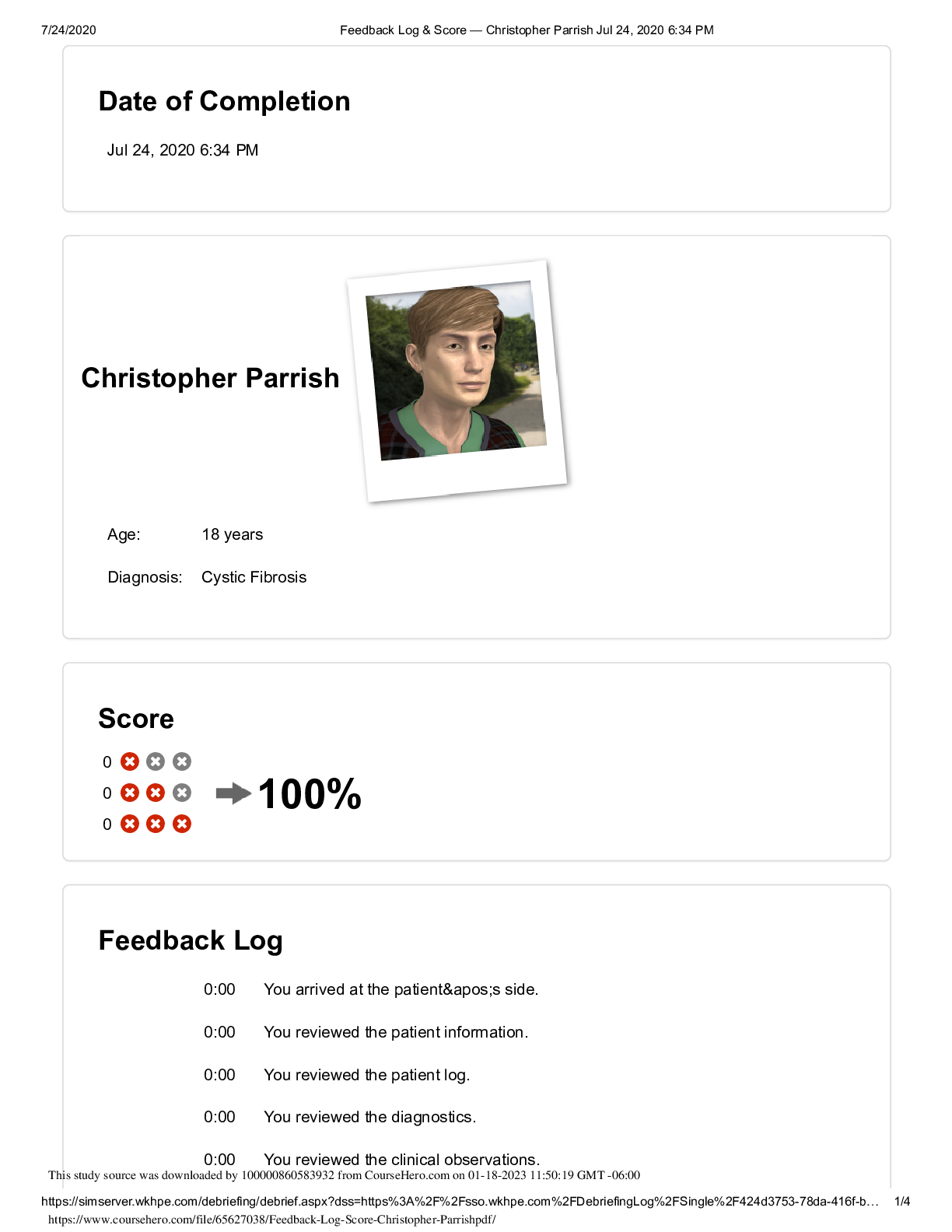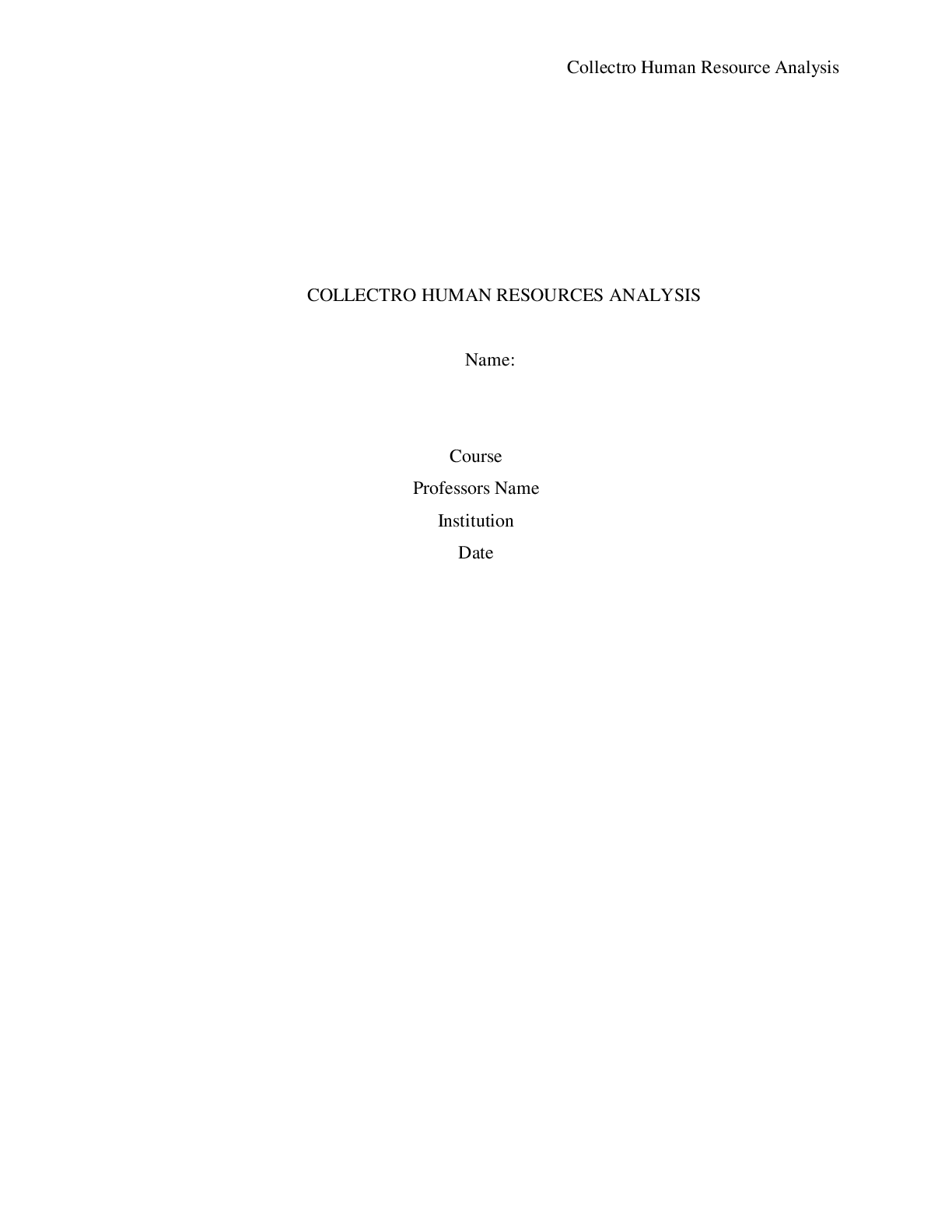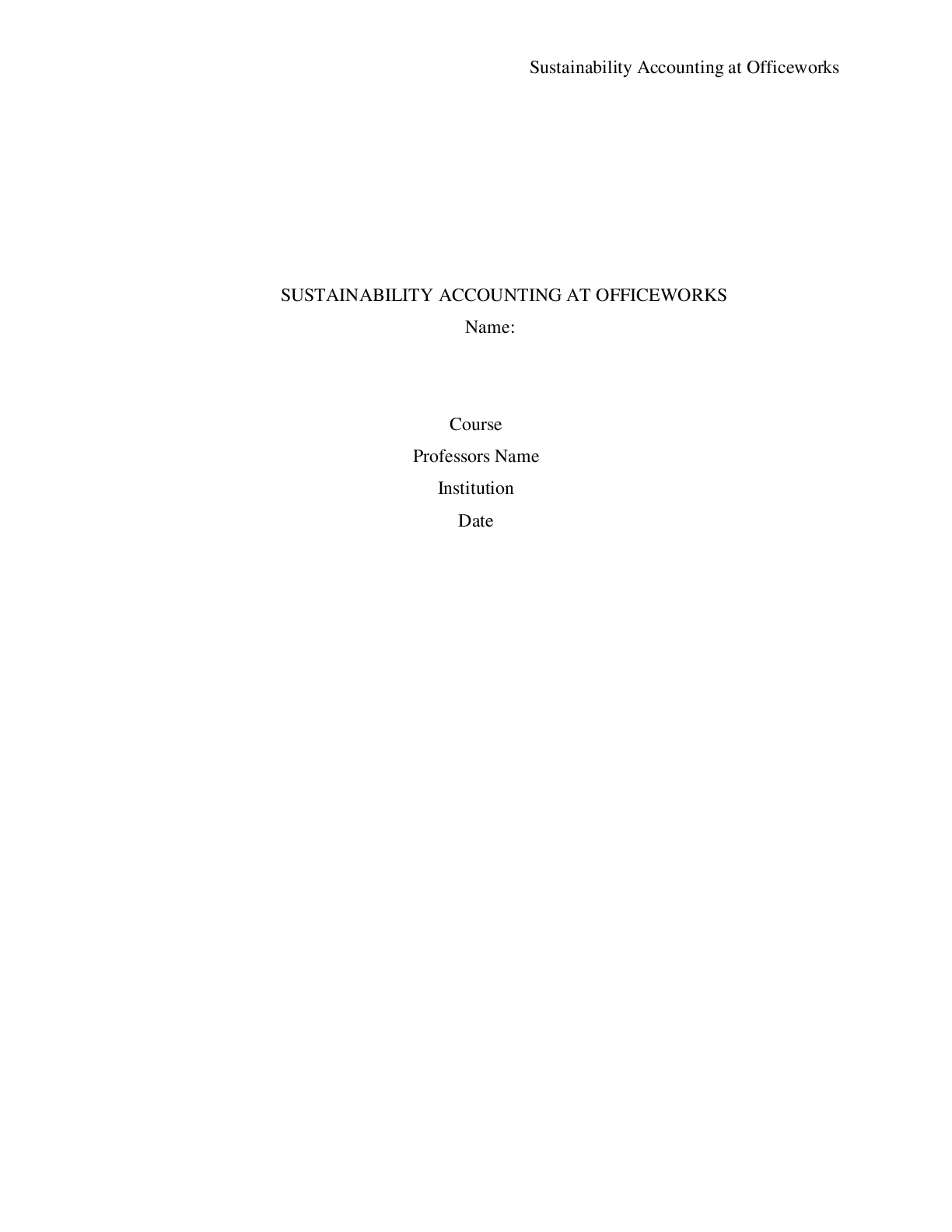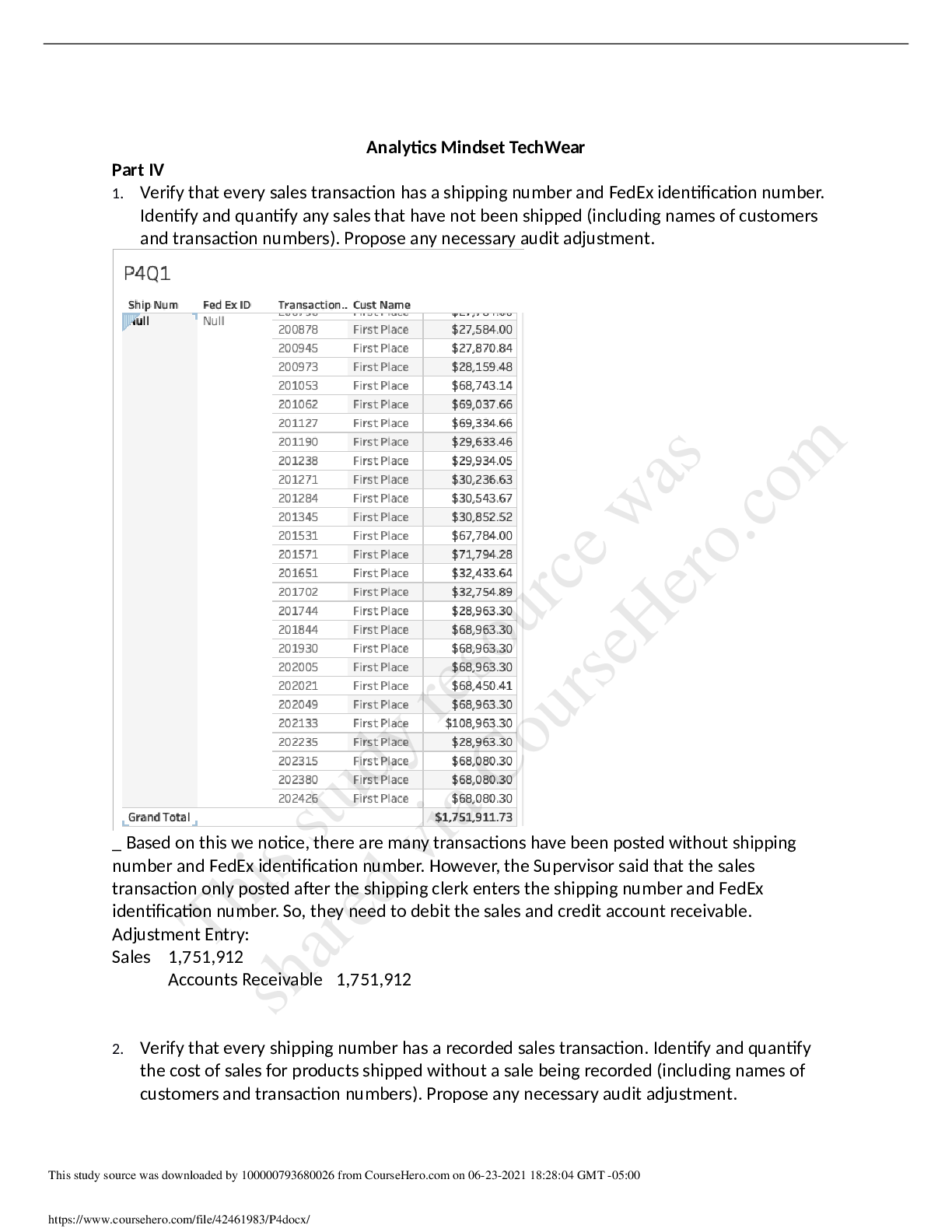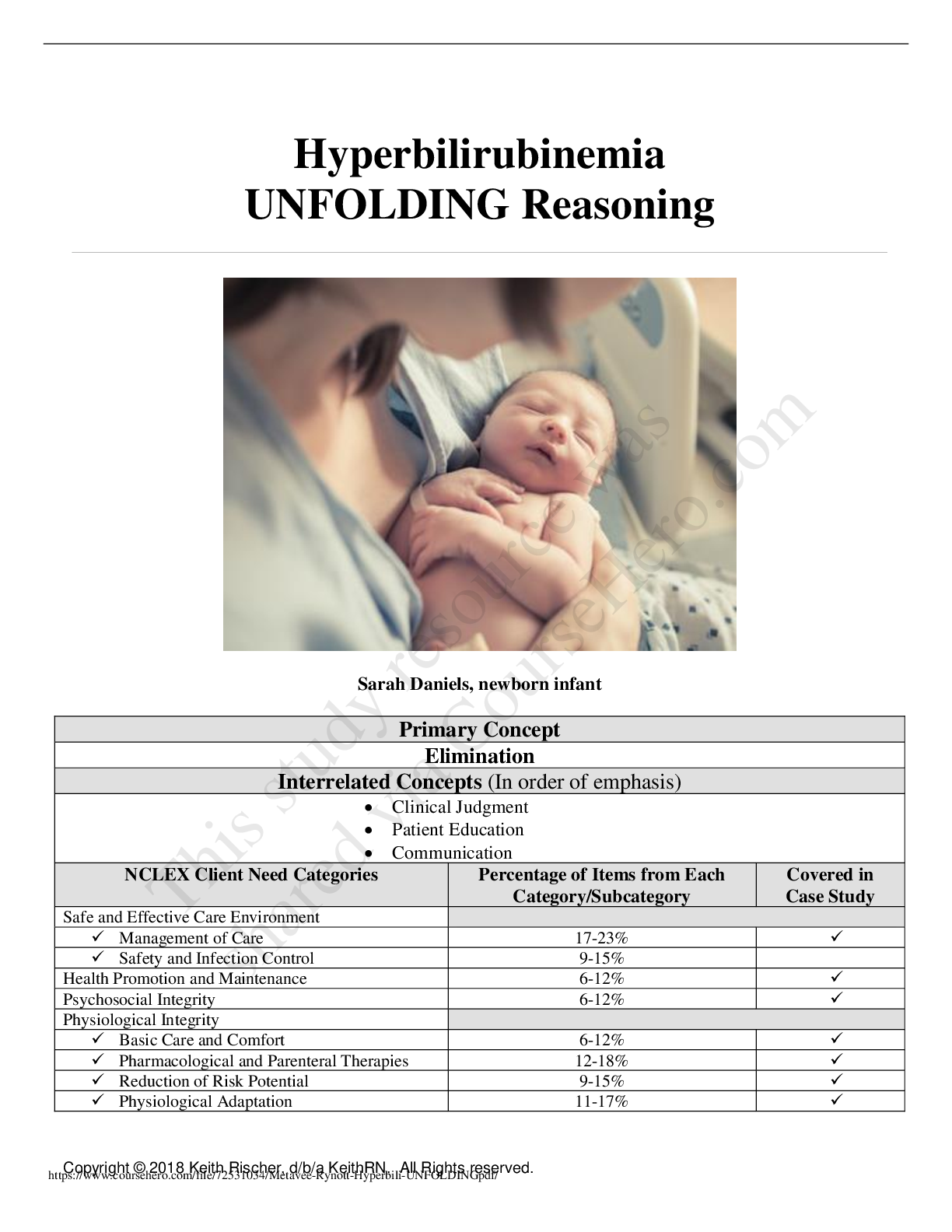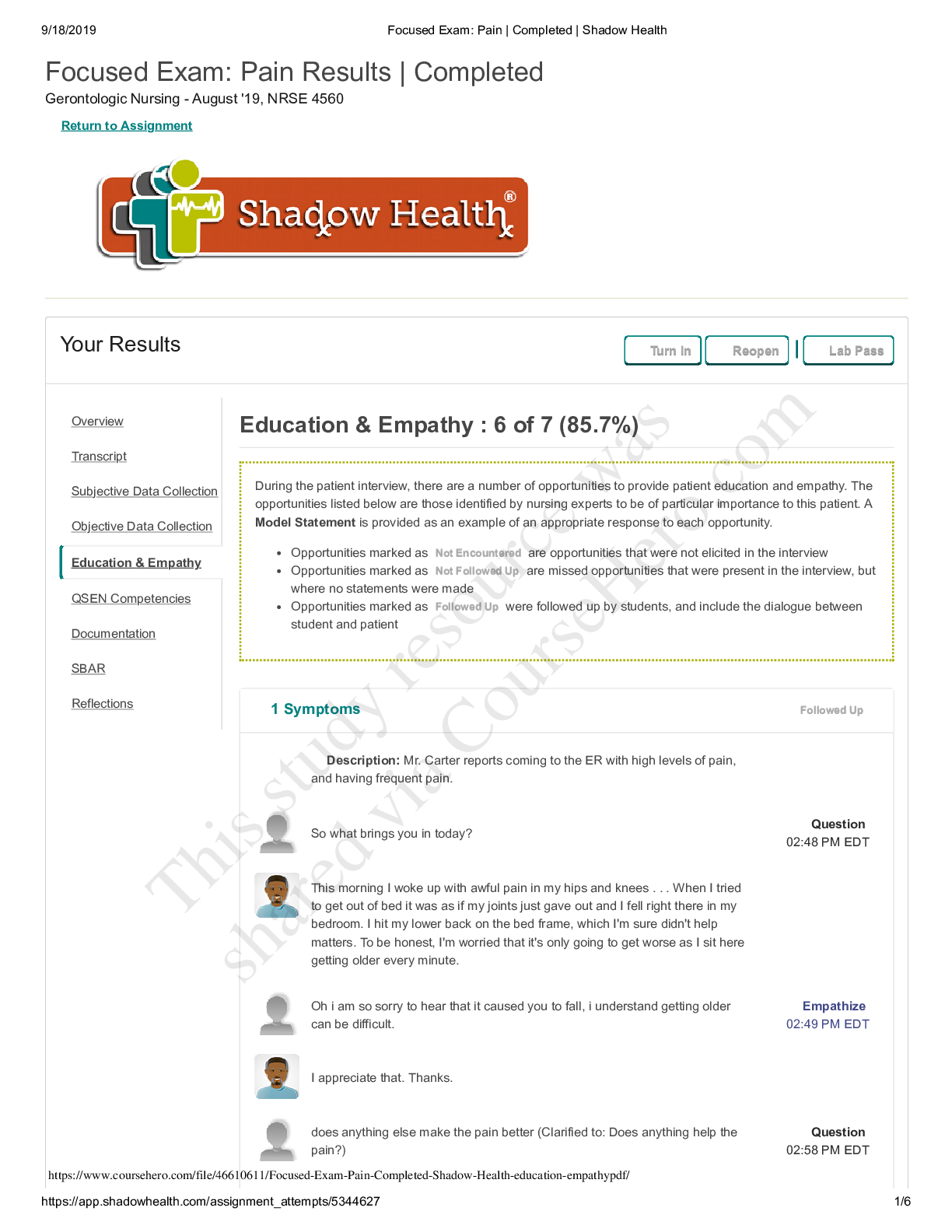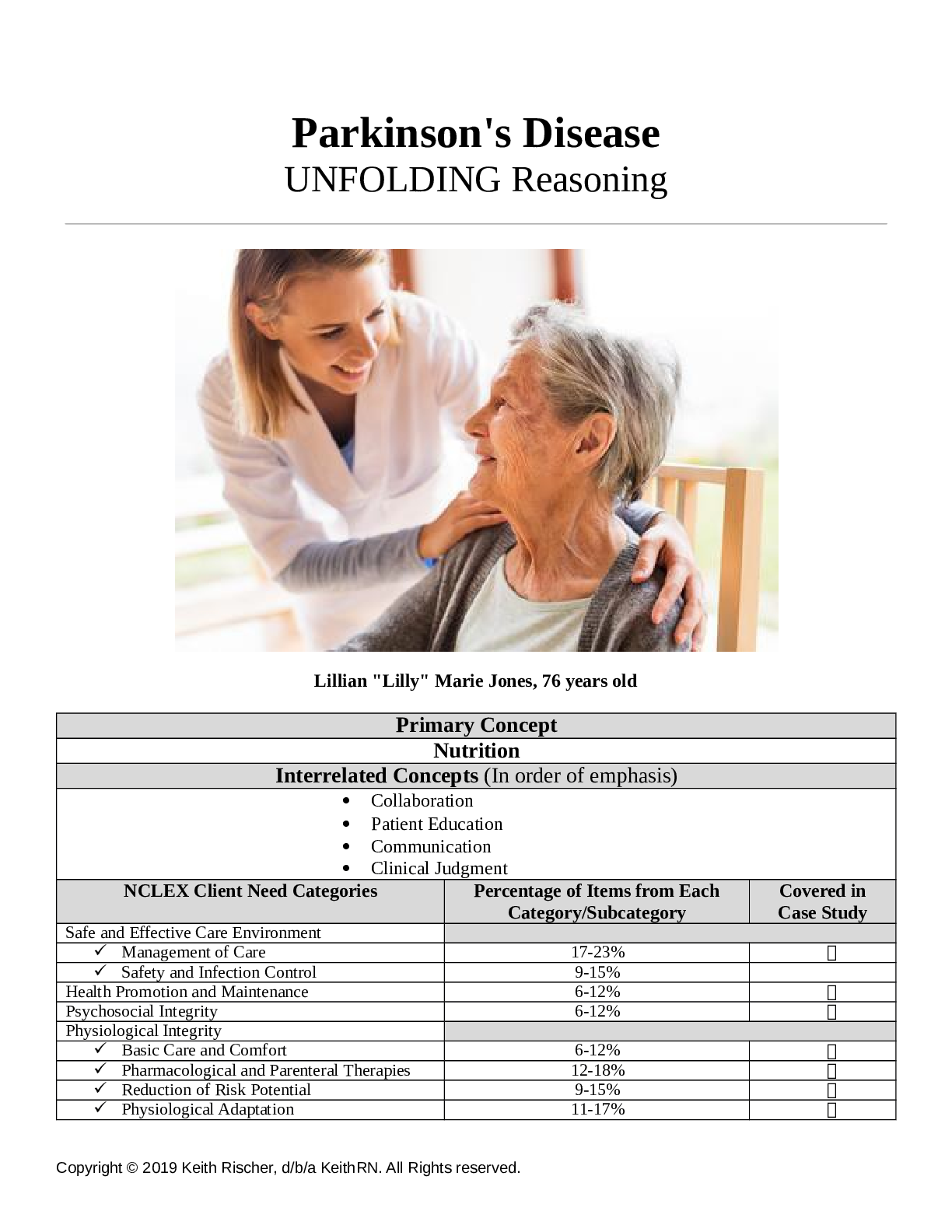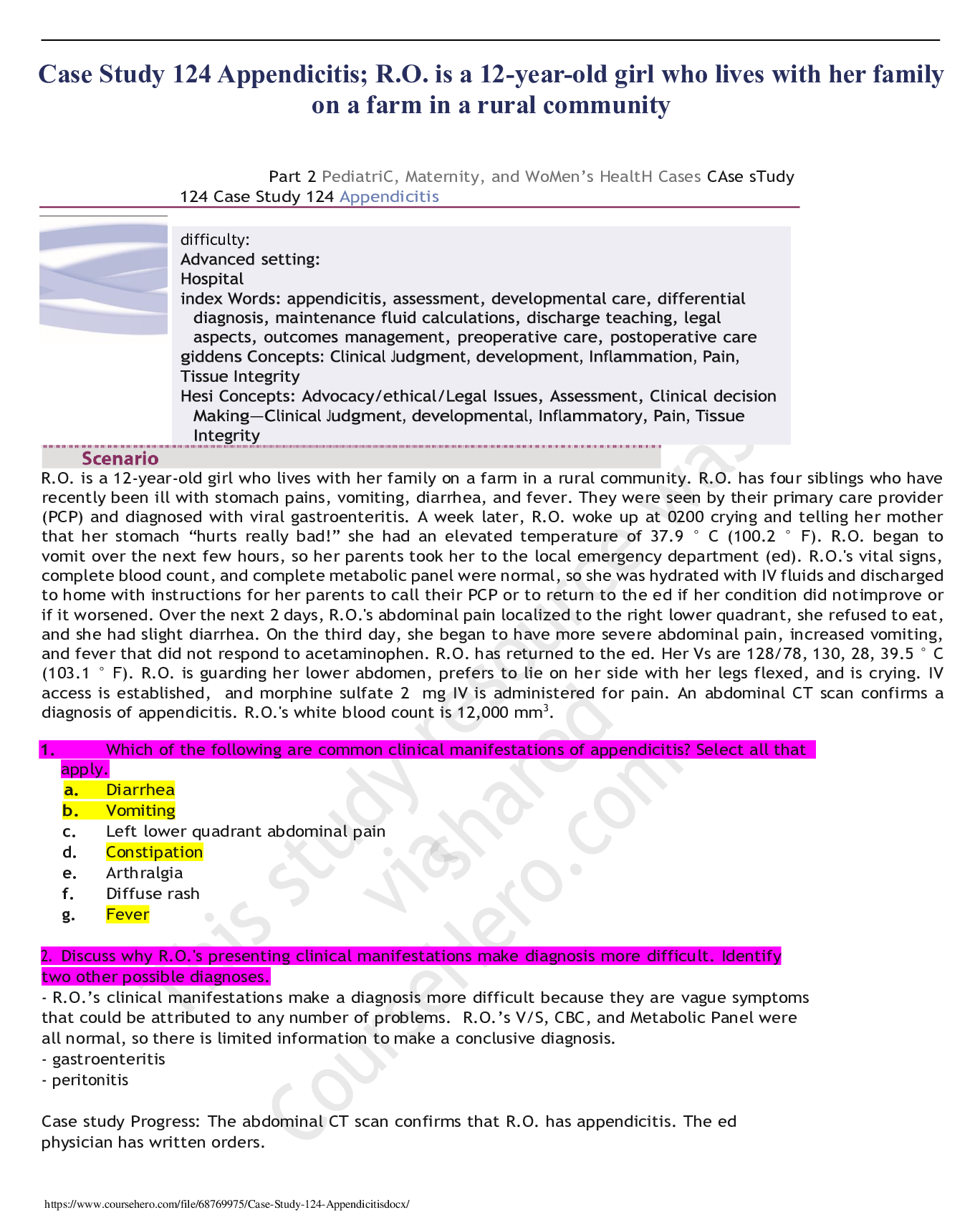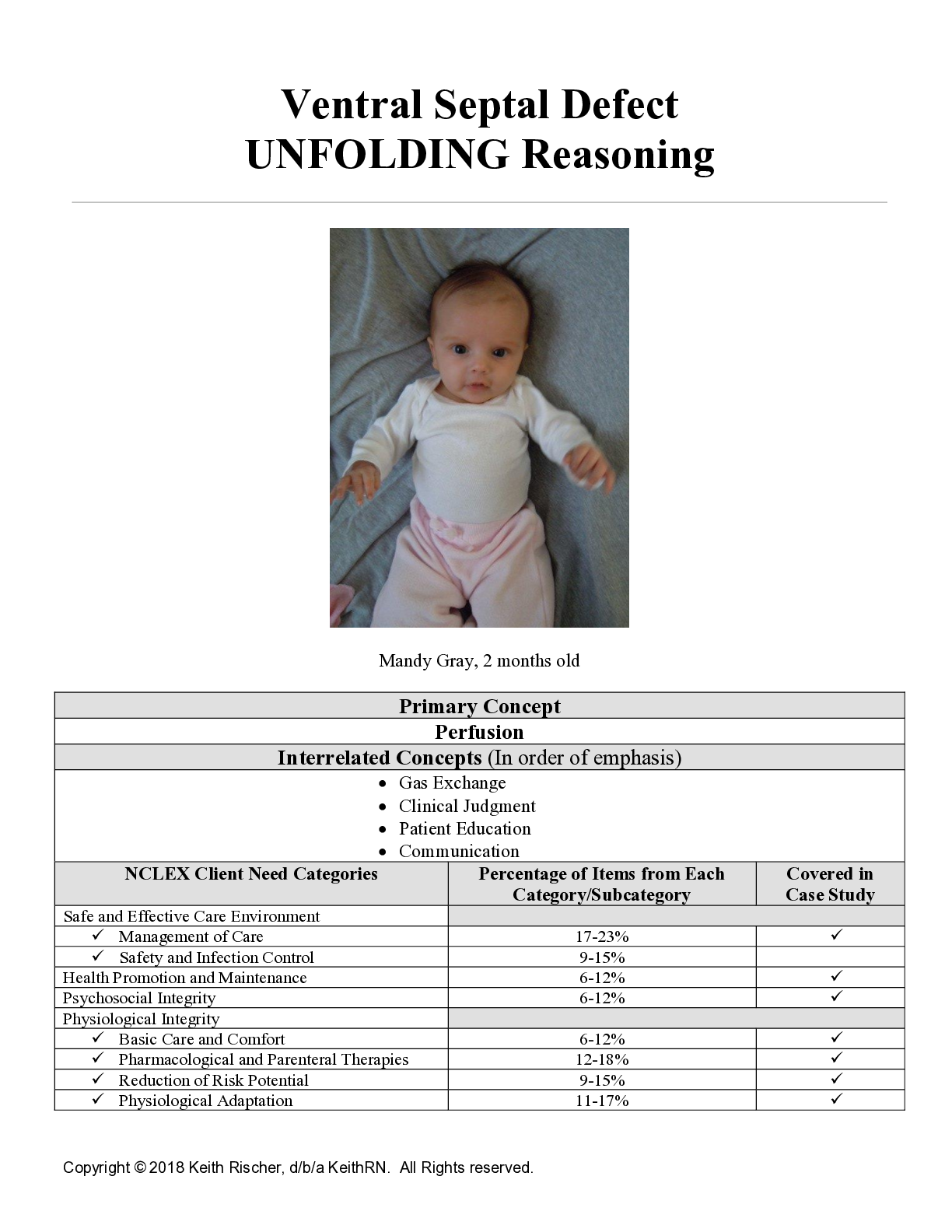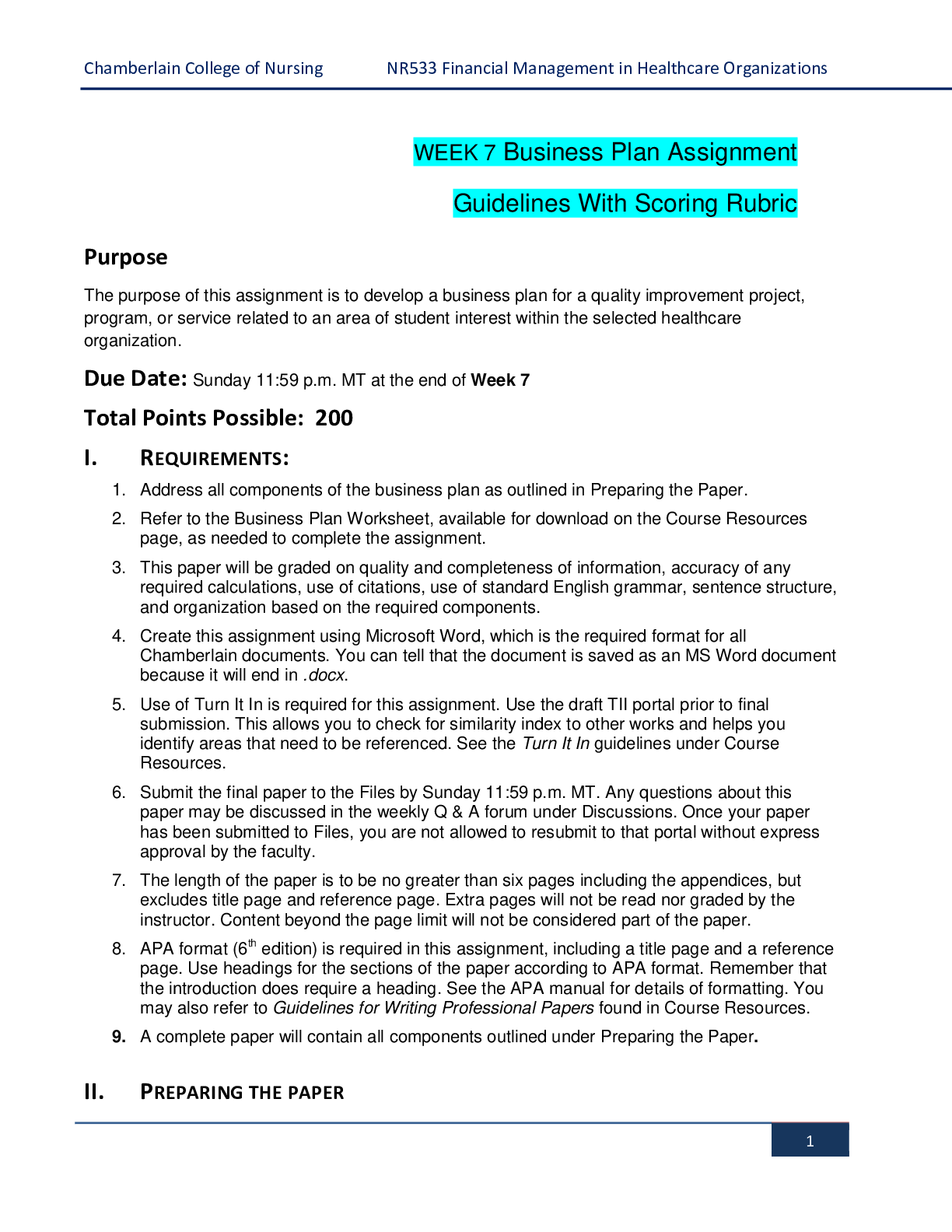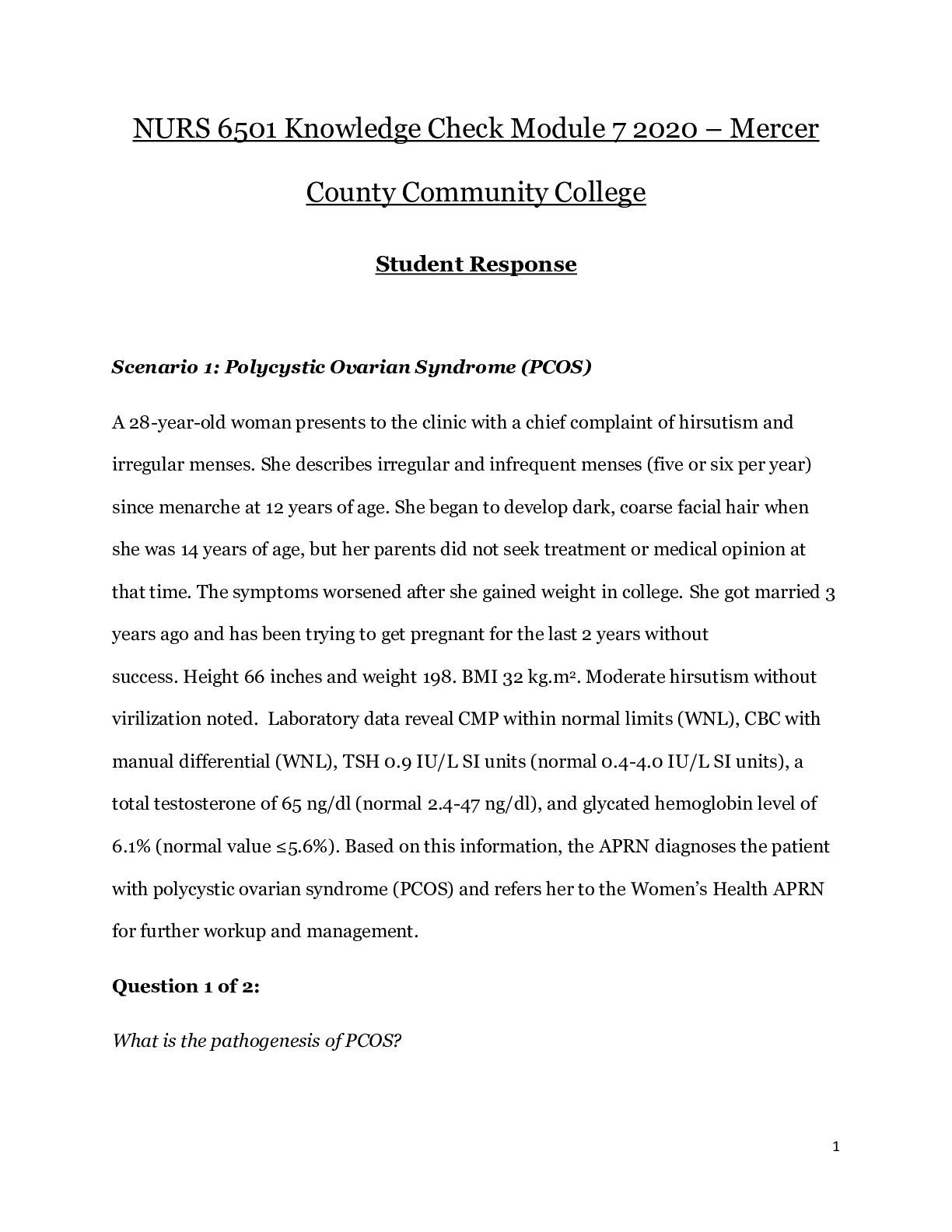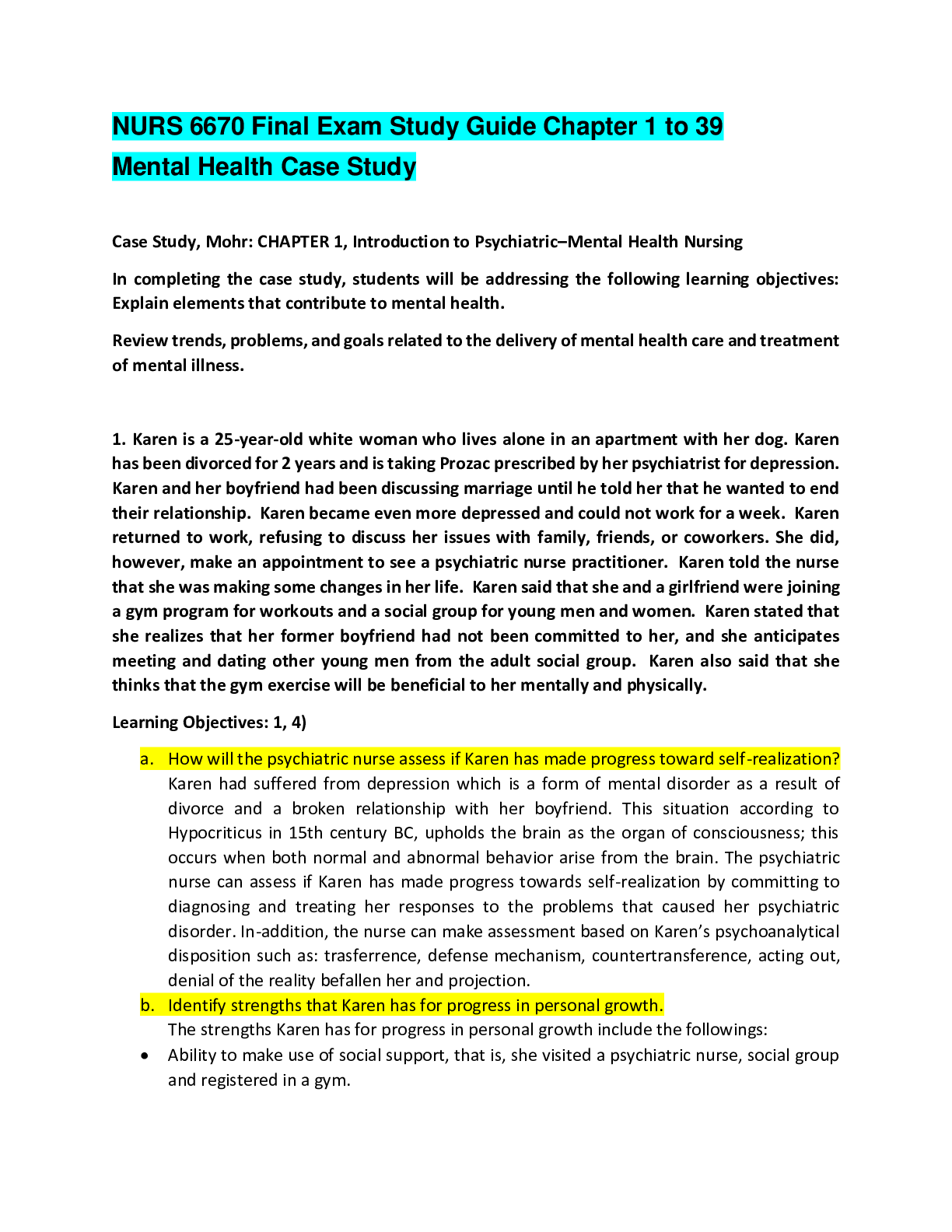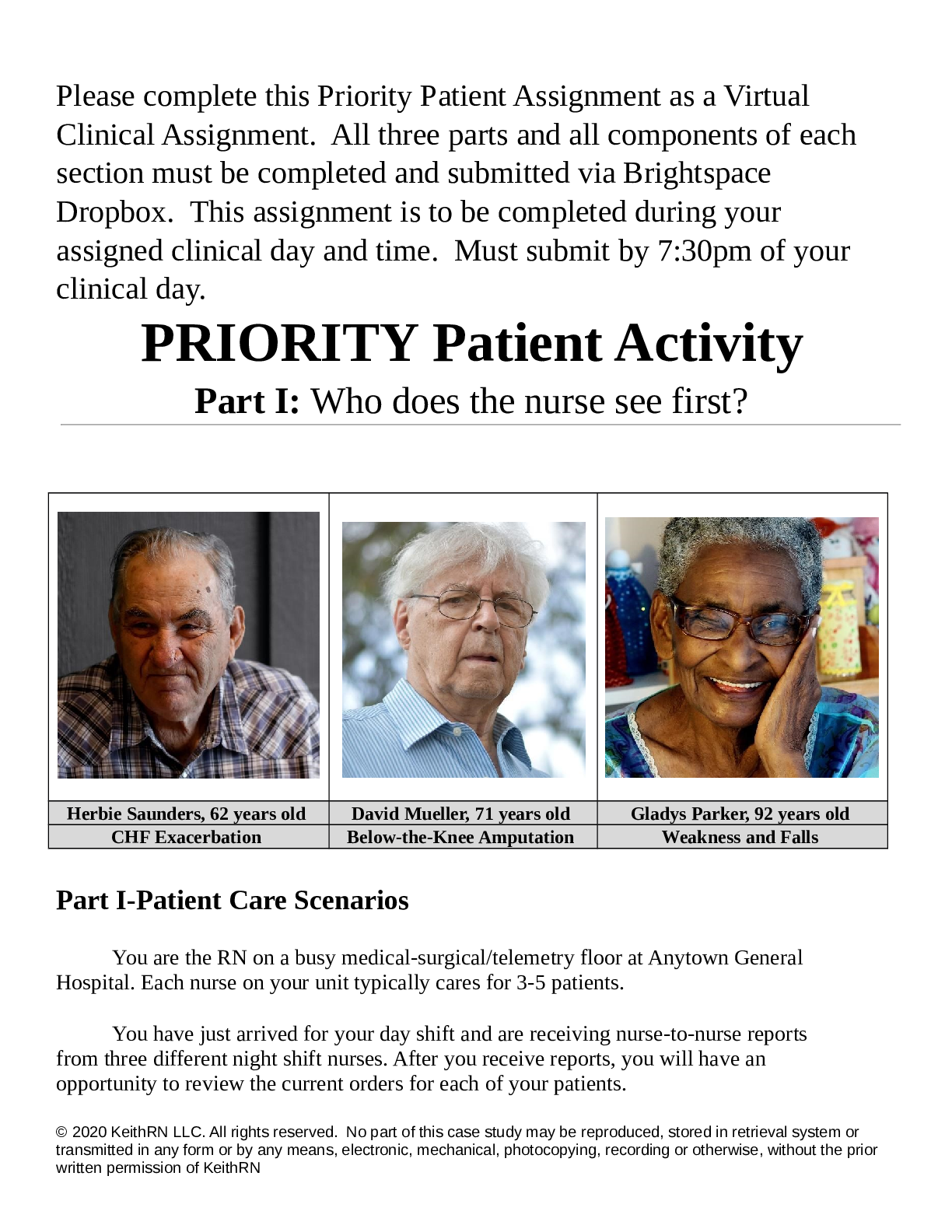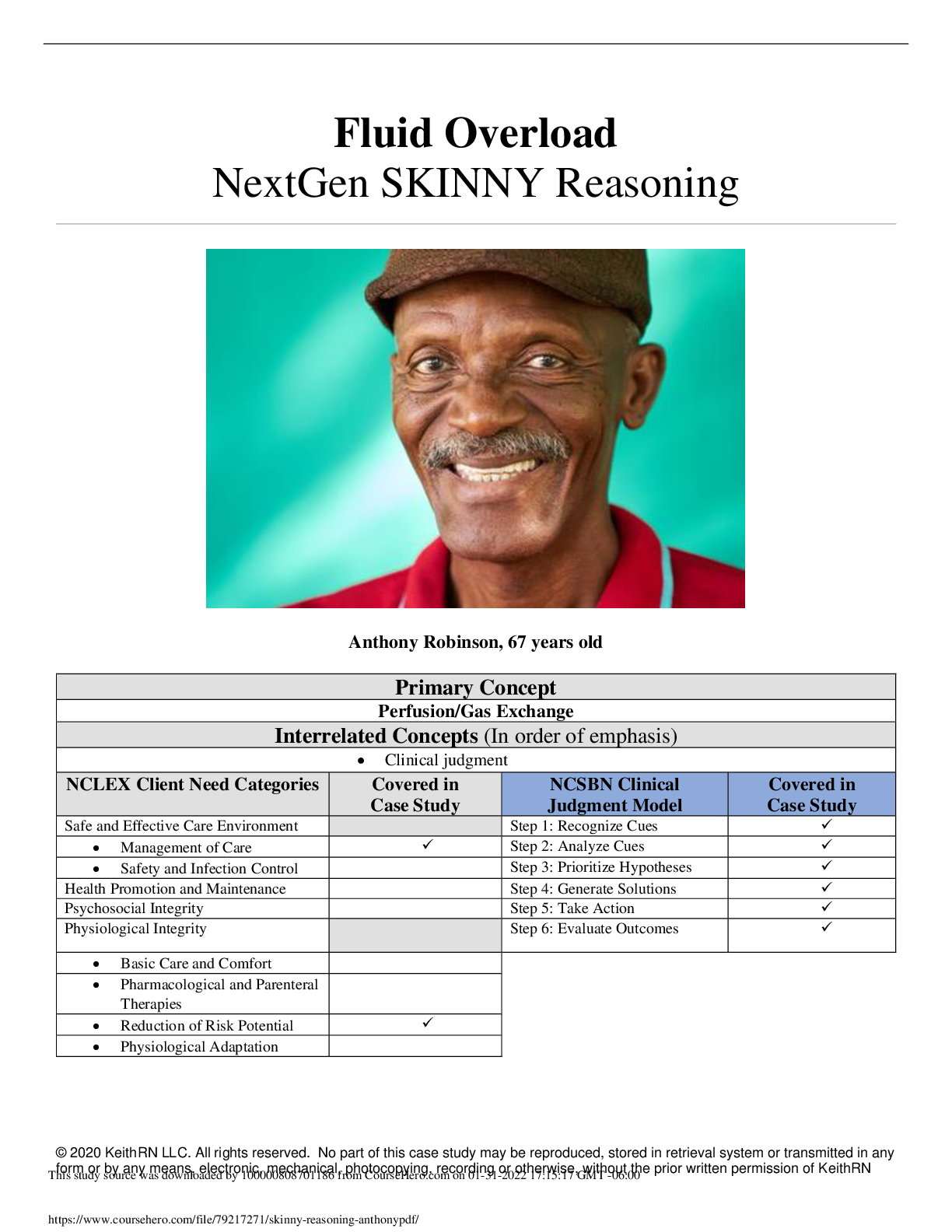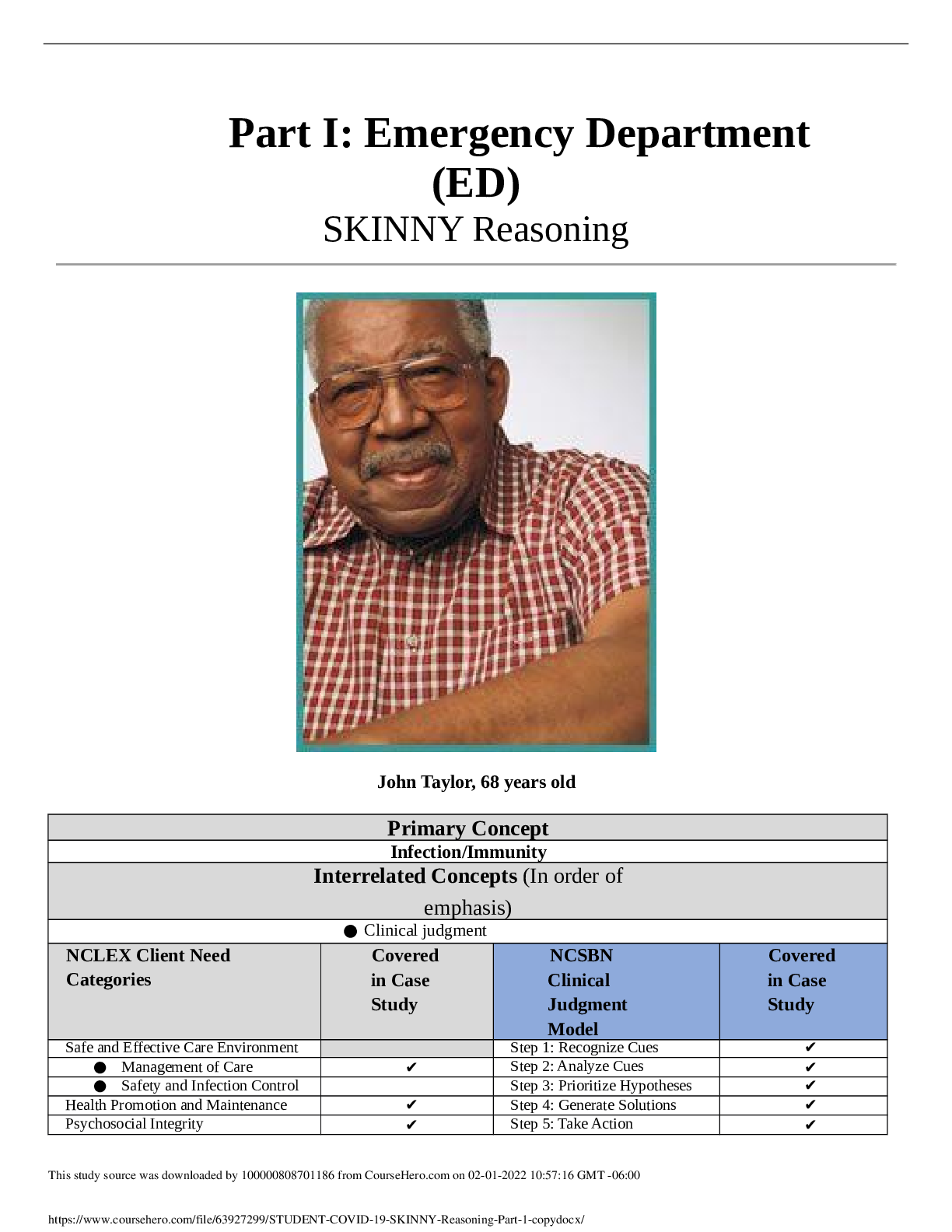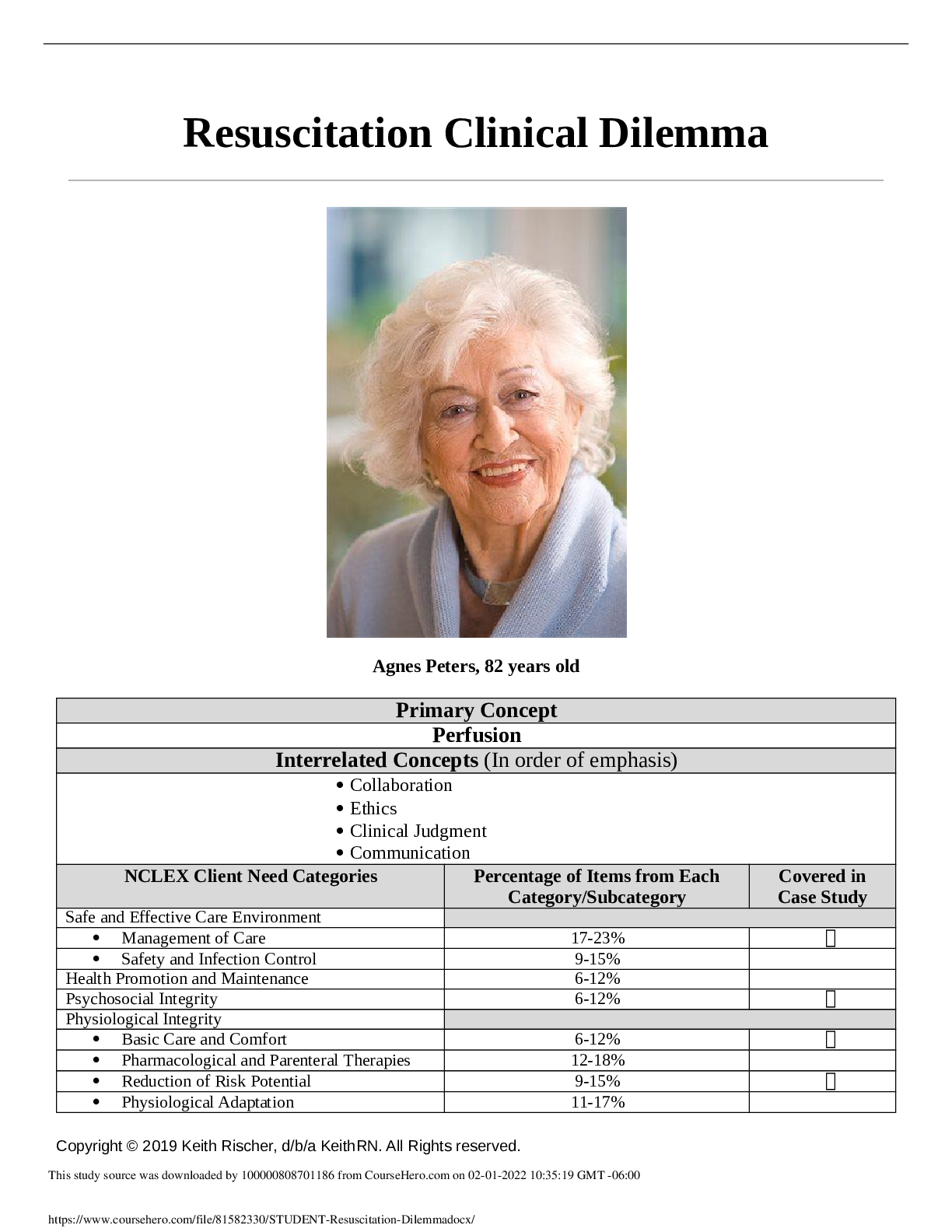*NURSING > CASE STUDY > VSIM 9 Vernon Russell Diagnosis: Right-sided stroke - Score 100% Scored, latest 2022/2023 (All)
VSIM 9 Vernon Russell Diagnosis: Right-sided stroke - Score 100% Scored, latest 2022/2023
Document Content and Description Below
DESCRIBE DISEASE PROCESS AFFECTING PATIENT (INCLUDE PATHOPHYSIOLOGY OF DISEASE PROCESS) Stroke occurs when the blood supply to part of your brain is interrupted or reduced, preventing brain tissue f... rom getting oxygen and nutrients. Brain cells begin to die in minutes. Two main causes of stroke are a blocked artery known as ischemic stroke or leaking or bursting of a blood vessel known as hemorrhagic stroke. Some people may have only a temporary disruption of blood flow to the brain, known as a transient ischemic attack (TIA), that doesn't cause lasting symptoms. Mayo Clinic. (2020, June 03). Stroke. Retrieved August 02, 2020, from https:// www.mayoclinic.org/diseasesconditions/stroke/symptoms-causes/syc-20350113 Lewis, S. M., Bucher, L., Heitkemper, M. M., & Harding, M. M. (2017). Medical-surgical nursing: Assessment and management of clinical problems. St. Louis, MO: Elsevier. DIAGNOSTIC TESTS (REASON FOR TEST AND RESULTS) PATIENT INFORMATION ANTICIPATED PHYSICAL FINDINGS Vernon Russel is a 55-year- • Tomography scan • Blood Glucose test to check blood sugar levels • HgbA1c1 • CBC • BMP • PT • INR old male admitted to the hospital 2 weeks ago for a stroke with mild lef hemiplegia. • weakness in the lef side of the body • some sensory losses in lef side • pupils are equal • mobility is decreased, and strength is weakened ANTICIPATED NURSING • Perform neuro assessment and vital signs per shif • Bedside blood glucose checks twice daily before breakfast and at bedtime • Medication as ordered by provider • Labs: CBC, BMP, PT, and INR • Patient will be educated on risk and prevention of falls. • Educate on the importance of passive range of motion exercises to increase mobility and circulation. • Physical therapy and Occupational therapy two times a day • Patient will be educated on how to manage symptoms or complications afer stroke vSim ISBAR ACTIVITY STUDENT WORKSHEET INTRODUCTION Aurora Vera primary nurse at the transitional care unit Your name, position (RN), unit you are working on SITUATION Vernon Russel is a 55-year-old male admitted to the hospital 2 weeks ago for a stroke with mild lef hemiplegia. Patient’s name, age, specific reason for visit BACKGROUND Admitted on 07/31/2020, Current Orders: Current Orders: Activity: Up with walker Vital signs and neuro-checks per shif Bedside blood glucose checks twice daily before breakfast and at bedtime Hgb A1c1 Diet as tolerated Labs: CBC, BMP, PT, and INR Medications: Aspirin 81 mg orally daily, Metformin 500 mg orally twice daily, Losartan 50 mg orally twice daily, Nicotine patch 1 mg once daily for 6 weeks, Chlorthalidone 25 mg daily Patient’s primary diagnosis, date of admission, current orders for patient ASSESSMENT Patient has limited range of motion of the lef shoulder to 160 degrees. Limited range of motion of the lef elbow to 140 degrees. Full range of motion of the other joints in the arms. Normal sensation for touch and pain on patient’s arms and hands. Active range of motion against gravity in the lef arm. Active range of motion against full resistance in the right arm. 3 out of 5 strength in the lef arm and hand grasp, and 5 out of 5 in the right arm and hand grasp. All skin free of lesions or scars; regular color and odor. Nails were smooth, clean, intact, with no signs of cyanosis or clubbing. Active motion against gravity in the lef leg and active motion against full resistance in the right leg. Lef hip flexion is limited to 80 degrees with full ROM in the other joints of the leg. Active ROM against no resistance in lef foot and active ROM against full resistance in the right foot. the patient’s vital signs were as follows: BP: 144/84 HR: 90 bpm RR: 16 SpO2: 98% Oral temp: 99F. Current pertinent assessment data using head to toe approach, pertinent diagnostics, vital signs RECOMMENDATION Perform neuro assessment and vital signs per shif Bedside blood glucose checks twice daily before breakfast and at bedtime Medication as ordered by provider Labs: CBC, BMP, PT, and INR Patient will be educated on risk and prevention of falls. Educate on the importance of passive range of motion exercises to increase mobility and circulation. Physical therapy and Occupational therapy two times a day Patient will be educated on how to manage symptoms or complications afer stroke Any orders or recommendations you may have for this patient PHARM-4-FUN PATIENT EDUCATION WORKSHEET NAME OF MEDICATION, CLASSIFICATION, AND INCLUDE PROTOTYPE MEDICATION: Aspirin CLASSIFICATION: NSAID PROTOTYPE: Salicylates SAFE DOSE OR DOSE RANGE, SAFE ROUTE Mild- moderate pain adult: 350 -650 mg every 4 hours or 500 mg every 6 hours child: 10-15 mg/kg every 4-6 hours PURPOSE FOR TAKING THIS MEDICATION Nonsteroidal anti-inflammatory used to reduce fever and relieve mild to moderate pain from conditions such as muscle aches, common cold, and headaches. It can also be use to reduce pain and swelling from conditions like arthritis(Holland,2007). PATIENT EDUCATION WHILE TAKING THIS MEDICATION • Take with food or milk to reduce GI symptoms • Do not give aspirin to children or teenagers with chickenpox or influenza like illness • Discontinue aspirin with onset of ringing or buzzing in the ears • Avoid alcohol when taking large doses of aspirin • Take as directed by provider • Avoid other medications containing aspirin due to danger of overdoes unless directed by provider Holland, R. (2007). Pearson Prentice Hall Rob Holland Drug Guide. Retrieved from http://www.robholland.com/ Nursing/Drug_Guide/ PHARM-4-FUN PATIENT EDUCATION WORKSHEET NAME OF MEDICATION, CLASSIFICATION, AND INCLUDE PROTOTYPE MEDICATION: Metformin CLASSIFICATION: Antidiabetic agent PROTOTYPE: SAFE DOSE OR DOSE RANGE, SAFE ROUTE Adult: PO Start with 500 mg q.d. to t.i.d. or 850 mg q.d. to b.i.d. with meals, may increase by 500–850 mg/d every 1–3 wk (max: 2550 mg/d); or start with 500 mg sustained-release with p.m. meal, may increase by 500 mg/d at p.m. meal qwk (max: 2000 mg/d) PURPOSE FOR TAKING THIS MEDICATION Treatment of type 2 diabetes mellitus in patients not controlled with diet alone. May be used with an oral sulfonylurea (Holland,2007). PATIENT EDUCATION WHILE TAKING THIS MEDICATION • Be aware that hypoglycemia is not a risk when drug is taken in recommended therapeutic doses unless combined with other drugs which lower blood glucose. • Report to physician immediately S&S of infection, which increase the [Show More]
Last updated: 1 year ago
Preview 1 out of 20 pages
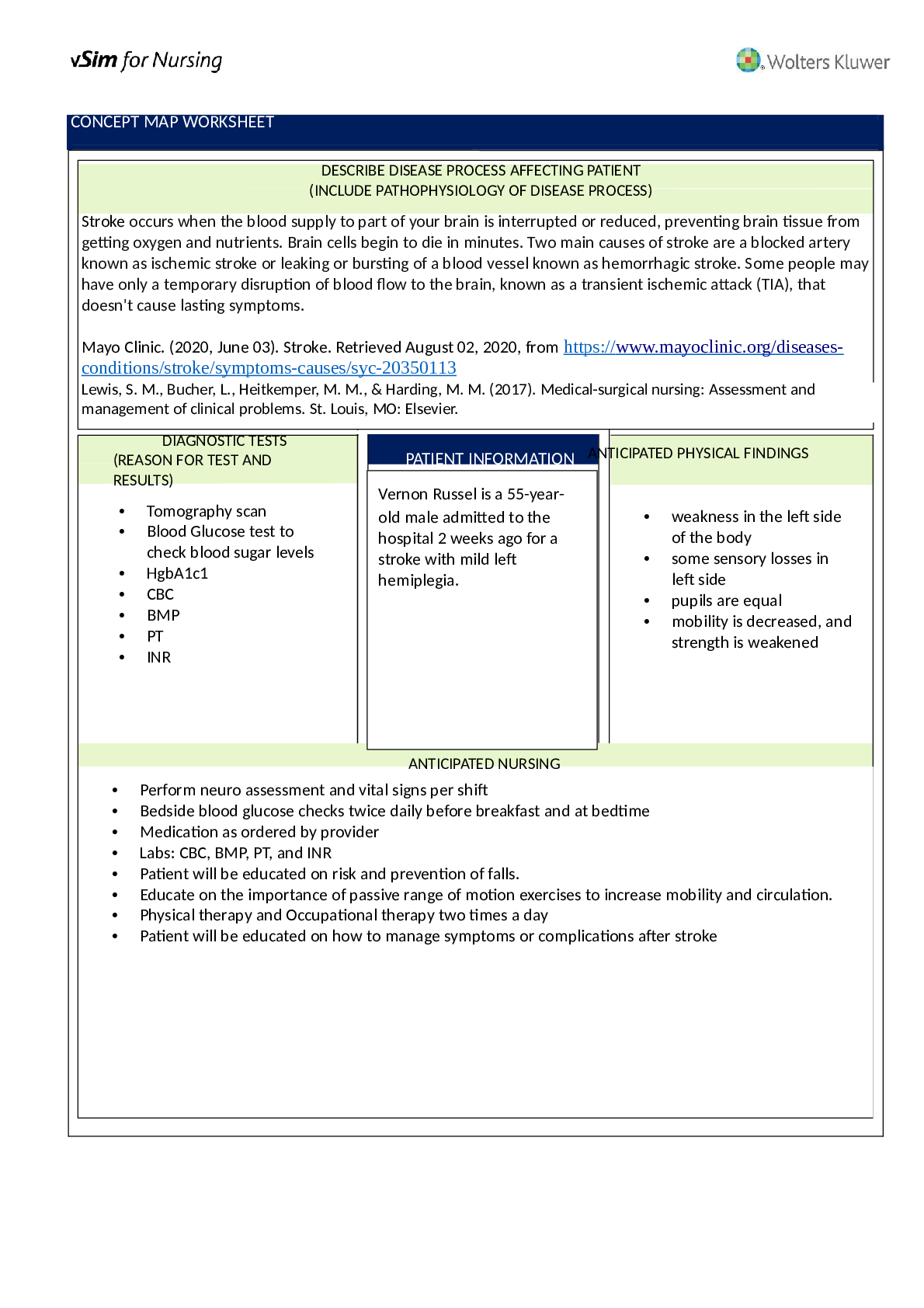
Reviews( 0 )
Document information
Connected school, study & course
About the document
Uploaded On
Jan 19, 2023
Number of pages
20
Written in
Additional information
This document has been written for:
Uploaded
Jan 19, 2023
Downloads
0
Views
71

